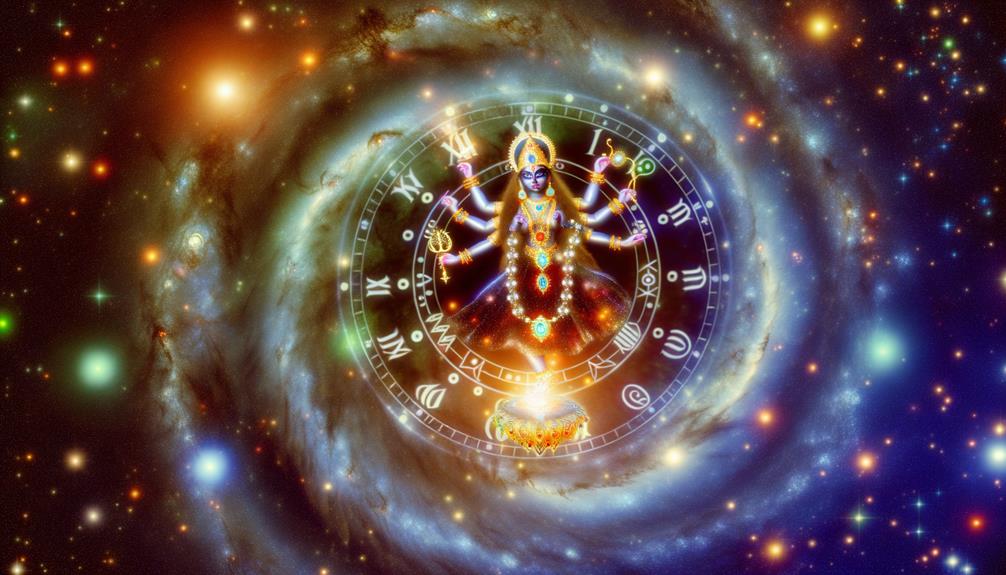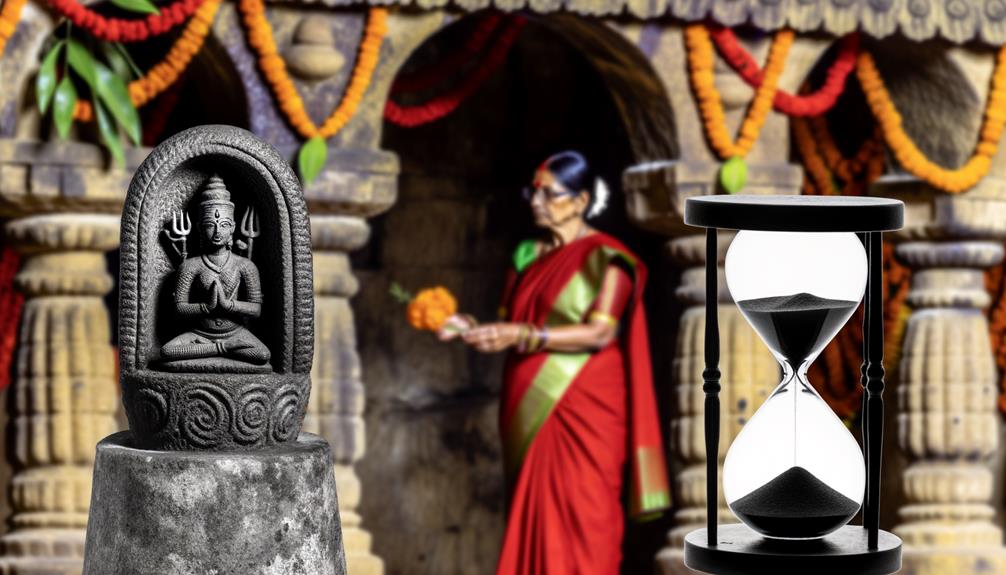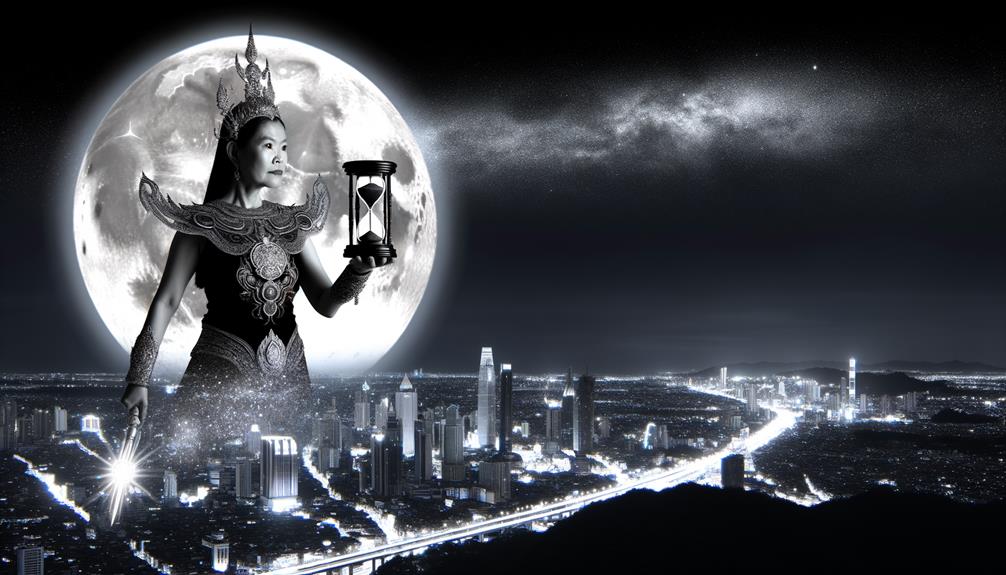Imagine, for a moment, the churning of a cosmic sea, much like the tales told in ancient Vedic texts. In Hindu mythology, time is seen as a cycle, not a straight line. It's a concept that has always caught my interest, especially when it comes to the fascinating figure of Kali, the Goddess of Time, Power, and Destruction.
The way she's depicted is as striking as the deep meanings she carries – a strong counterpoint to the Western idea of time as a steady, one-directional progress.
Kali is more than just a symbol of mortality. She serves as a reminder of time's cyclical nature, the rhythms of creation and dissolution. She's not just a fearsome deity, but a deep philosophical concept that pushes us to think about life's fleeting nature, the certainty of death, and the deceptive idea of linear time.
So, if these ideas have you intrigued, as they do me, you're likely eager to learn more about Kali and her dominion over time.
Understanding Kali's Time Power

Let's talk about the amazing concept of time power, attributed to the Hindu goddess Kali. It's truly a deep and meaningful idea, showing us the cycles of creation and destruction that shape our universe. It's like a wake-up call, reminding us that nothing in life is permanent, not even life itself.
Kali, the goddess of time, is a powerful figure that forces us to face our own mortality. She highlights the relentless flow of time and the inevitability of death.
In Hindu culture, the image of Kali Ma is quite fierce – her tongue is often shown sticking out, a bold act of defiance. This is seen as a symbol of overcoming one's ego and going beyond the desire for material possessions. Those who worship her, call her Kali, the timeless one, looking for her help in their spiritual journey and their quest to break free from the boundaries of the physical world.
In my view, to truly grasp the concept of Kali's time power, we've to go beyond the idea of life's impermanence. We also need to understand her role in helping people face their problems, accept change, and rise above the physical world's constraints.
Kali's worship isn't limited to Hinduism. Her influence is wide-reaching, even inspiring feminist movements, and becoming a symbol of empowerment for many. Through Kali, we learn that time, the great equalizer, can also be a force for change, transformation, and ultimately, liberation.
Kali's Role in Cosmic Cycle

When we talk about Kali's function in the grand scheme of the universe, we see that she's essentially the beat of life's drum, constantly shifting between creation and destruction to keep things balanced and fresh. Kali, an incarnation of the goddess Durga, holds a place of prominence in Tantric teachings. She's had a dedicated following for hundreds of years as the goddess of death, representing the hard truths of life's cycle.
Kali is often depicted with wild, untamed hair and a third eye, a symbol of her divine wisdom and strength. She's a fearsome figure, but her part in the universe's cycle is crucial.
Whether it's a matter of geography or symbolism, Kali is at the heart of life and death, creation and destruction.
Kali helps facilitate the necessary breakdown for fresh growth in the universe's cycle, representing the ongoing give and take of existence.
Her role in the cycle of life and death is a reminder of the constant change and transformation, underlining the fleeting nature of existence.
The Symbolism of Kali
Let's delve into the fascinating world of Kali, shall we? When we explore her symbolism, it's like stepping into a rich, intricate world of myths, mysteries, and deep spiritual insights. Kali is more than just a character in a story. In the Hindu tradition, she's an essential figure, symbolizing life, death, creation, and destruction.
You might know Kali as the dark mother or the black goddess. She stands as a strong symbol of Mother Nature at her rawest and most primal. Kali represents time's power, reminding us of the unavoidable truth of death. But she also symbolizes the cycle of life, showing us that existence is a never-ending circle. Her dark complexion is a symbol of transcendence, embodying the endless void from which life emerges and inevitably returns.
Kali's imagery is a strong symbol of female power. Her wild hair, protruding fangs, and the necklace of human heads she wears all signify her fierce and untamed nature. As a mother goddess, Kali is both a giver and taker of life, highlighting the two-sided nature of existence. The lesson we take from her is that creation and destruction are just two aspects of the same reality.
Worship and Reverence of Kali

Kali worship is a deep-rooted tradition that goes back to the Pre-Aryan Period. This figure, the first among the ten Mahavidyas in the Hindu tantric tradition, has sparked curiosity and devotion worldwide, not just in South Asia. Kali, a representation of female power, garners a following from all over the world, but she's particularly adored in Bengal, India.
Let's have a casual chat about the four key elements of Kali worship:
- Everyday Rituals: The bond between Kali and her followers is evident in the daily rituals performed before her image. It's not just about seeking protection and blessings. It's about the unique connection between the worshipper and the deity.
- Devi Mahatmya: Kali plays a pivotal role in the Devi Mahatmya, a Sanskrit text from the Markandeya Purana. This text is a big deal in Shaktism, making Kali's presence even more significant.
- Feminine Form: Kali is more than just a deity. She's a symbol of powerful, destructive, and transformative femininity. People turn to her in challenging times, seeing her as a representation of life's cycles.
- Tantric Worship: Kali is seen as a liberator within Hindu and Tantric traditions. Her followers believe she can help them see through the illusions of the physical world.
Kali's Influence in Modern Times

Kali, the Hindu Mother Goddess, holds a significant spot in the spiritual consciousness of India, from the frosty valleys of Kashmir to the balmy beauty of Kerala, and the lively cultures of Bengal and Assam. The presence of Kali in the present day is undeniable and impactful.
Kali's multifaceted nature – both destructive and nurturing – has struck a chord in New Age spirituality. Many people view her as the epitome of empowerment and transformation. Her intense depiction, with her tongue sticking out, has been embraced by global feminist movements. I think this speaks volumes about her timeless relevance, and her ability to remain significant and inspiring in an ever-changing world.
Artists, writers, and scholars have been influenced by Kali's reinterpreted origins and mythologies, representing a significant departure from the traditional comprehension of the Goddess. Kali isn't just a relic from the past, but a dynamic entity. Her influence continues to mould our modern world, demonstrating her continued vitality and relevance.
Frequently Asked Questions
Why Is Kali the Goddess of Time?
So, why is Kali seen as the goddess of time, you ask? Well, it's mainly because she reflects life's endless loop of birth and death. Her role in mythology bears the weight of destruction and creation, all while acting as a constant reminder of time's unstoppable march.
What Is the Power of the Goddess Kali?
Kali, the goddess, is potent and transformative, similar to a wild tempest. She is the personification of raw energy, the force that eradicates evil, and the source of creation. Her intense persona encourages women to be true to themselves, enabling them to tackle life's obstacles with courage and determination.
What Is the Most Powerful Form of Kali?
From what I've gathered, Mahakali takes the crown as the most formidable incarnation of Kali. This figure is viewed as the ultimate reality and force, personifying the universe's cosmic energy. Her character is a testament to the boundless power of change and transformation in the cosmos.
What Is Kali Time?
'Kali time' isn't about a swanky timepiece brand. It's actually about the Hindu goddess Kali and her deep connection with time. It's about her powerful destructive and transformative qualities, representing the inevitable conclusion of all things as time moves forward. This represents a powerful symbol of the cycle of life and death.
Conclusion
When you think about Kali, you'll find yourself wrestling with a potent mix of conflicting traits. She's intense, but it's not that simple. She isn't just a goddess famed for destruction; she also stands for time and change, representing the fleeting nature of everything.
Her imagery is stark, simultaneously terrifying and nurturing, pushing us out of our comfort zones and commanding our respect. The fact that Kali continues to leave her mark on modern society speaks volumes about her multifaceted allure.
The duality of her character, as both a force of destruction and freedom, makes her an intriguing goddess, a cryptic symbol of power and metamorphosis.

